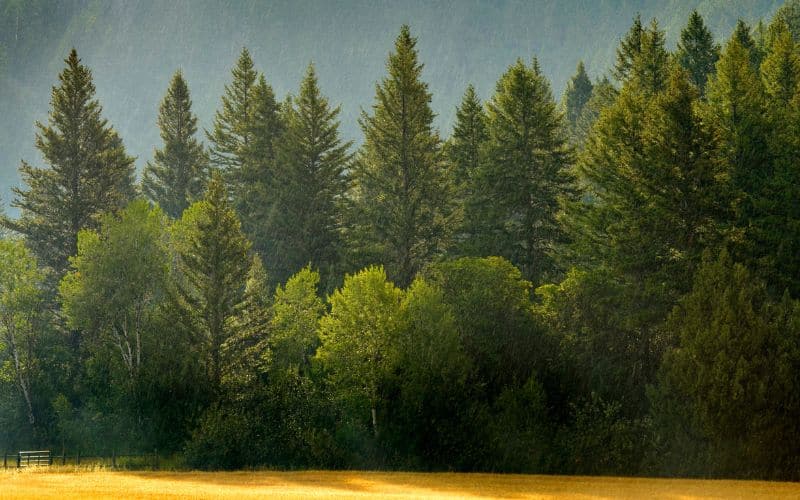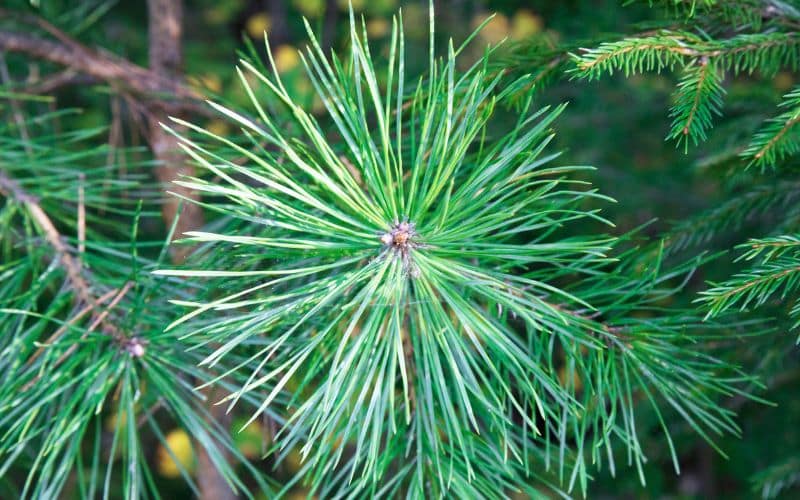
Identifying pine trees by their needles is a fascinating aspect of tree identification that can tell you a lot about the species you’re looking at. With pines varying from soft, five-needle clusters to hard, single needles, each type offers unique clues to its identity.
Whether you’re strolling through a forest or admiring trees in a park, understanding needle length and type can transform your outdoor experience. Pine needles range from the short 1-2 inches of the Scots Pine to the lengthy 8-17 inches of the Longleaf Pine, revealing the diversity within this coniferous family.
Why is pine tree identification important?
Understanding the Different Types of Pine Trees
Pine trees, known for their evergreen foliage and conical shape, are more than just a picturesque part of the landscape; they’re a diverse group with over 100 species, each with unique characteristics. Knowing the specific type of pine tree can inform you about the best care practices, potential growth patterns, and the tree’s suitability for your local environment.
Some pines thrive in sandy soils, others in wet marshlands, and identifying them correctly ensures they’re planted in the right environment to flourish. For instance, the Longleaf Pine, famous for its long needles, prefers dry, sandy soils, while the Eastern White Pine, with its clusters of five needles, is more tolerant of colder, moister climates.
Understanding these nuances can guide decisions in various sectors. Timber companies depend on species differentiation to select trees with the optimal wood quality for their products. Landscapers look for species that will fit the design and function for urban and rural projects, balancing aesthetics with ecological suitability. Communities and city planners might choose pine species based on their tolerance to pollution and urban stresses when greening city spaces.
Importance of Needle Identification
The ability to identify pine trees by their needles is essential, as the needles offer the most distinguishable features. Each species of pine has a unique needle arrangement, which can affect not only the appearance but the tree’s adaptation to its environment.
Identifying pines by their needles isn’t just about distinguishing one species from another; it’s also about recognizing the health of the tree. Yellowing needles might indicate a nutrition deficiency or a disease specific to that pine species. This information is crucial for conservationists and horticulturists aiming to maintain healthy tree populations and for homeowners wanting to ensure the vitality of their gardens.
Moreover, accurately identifying pines by their needles has important implications for wildlife ecosystems. Certain birds and animals depend on specific pine species for habitat. For example, the Red-cockaded Woodpecker nests almost exclusively in Longleaf Pines. Without accurate identification, efforts to conserve or restore these habitats could be misdirected.

Characteristics of pine tree needles
Pine trees, a beloved symbol of the forest, hold a treasure trove of clues in their needles that can help you easily distinguish them from other evergreen species.
Length of Needles
When you’re out in the woods, have you ever noticed how pine needles differ dramatically in length? Pine tree needles exhibit considerable variance in size, which can serve as a sure-fire distinguishing characteristic. Generally, the needles grow in clusters known as fascicles, and depending on the species, the number of needles in a fascicle can vary. For example:
- White Pines: Traditionally, these have five needles per fascicle, and they can grow impressively long, often several inches in length.
- Red Pines and Yellow Pines: These varieties usually showcase needles in clusters of two to three. The length of these needles typically falls within a range of four to six inches, although some species may have slightly different lengths.
Remember, when identifying a pine tree, taking note of needle length is a critical first step.
Colour of Needles
The color of pine needles can provide subtle hints about their species. The shades of green sometimes bridge into blue or yellow tones, giving these trees distinct visual markers.
- White Pines: Their needles often exhibit a bluish-green hue, lending these trees a serene and cool appearance.
- Scotch Pine: Known for its sylvan beauty, it offers up a greenish-yellow coloration, which is especially vibrant in the sunlit frosted landscapes.
The color variation might be slight, but it’s a valuable identifier when you’re comparing pine trees side by side.
Texture of Needles
Ever touched a pine needle and noticed its texture? Pine needles can be stiff and sharp or flexible and soft, depending on the species. This tactile aspect is another essential identification feature.
- Longleaf Pines: Their needles are notably stiff and robust, making an unmistakable impression upon handling.
- Eastern White Pine: In contrast, this species has soft, flexible needles that bend easily between your fingers.
The texture of the needles can sometimes reflect the tree’s adaptability to its environment; for instance, stiffer needles often indicate a tree’s resistance to drought or poor soil conditions.

Common types of pine trees
As you delve into the world of coniferous flora, the task of identifying pine trees by their needles can be both enchanting and enlightening. In this segment, you’ll explore the distinct features of some common types of pine trees so you can recognise them with ease.
Scotch Pine
Known for its traditional use as a Christmas tree, the Scotch Pine, also referred to as the Scots Pine, offers telltale identifiers for your botanical pursuits:
- Needles: Blue-green needles occur in pairs, approximately 4 cm long, with a twisted form.
- Cones: Small, with a length of about 3 to 7 cm, often with a curved shape.
- Bark: Flaky bark in upper parts of the tree, which can appear in shades of orange-brown, provides a unique ornamental texture.
In natural settings or tree farms, Scotch Pines stand out for their robust growth, often reaching between 30 to 60 feet in height, suited to hardiness zones 3 to 7.
Eastern White Pine
The graceful Eastern White Pine is distinguished by:
- Needles: Carrying bundles of five soft, flexible needles that are slender and can grow up to 13 cm long, rich in a delicate blue-green hue.
- Cones: Slim, long cones measuring between 8 to 20 cm contribute to their characteristic profile.
- Bark: As the tree ages, the bark becomes deeply fissured, transitioning from smooth and gray-green in youth to shades of darker gray-brown.
If you’re out in the wilderness of North America, you might spot the Eastern White Pine towering well above the forest canopy, as they can grow beyond 100 feet under optimal conditions.
Lodgepole Pine
Venture into the more rugged terrains, and you’ll likely encounter the resilient Lodgepole Pine:
- Needles: Paired needles that are quite short, around 4 to 7 cm in length, with a sturdy and slightly twisted appearance.
- Cones: Cones remain tightly closed on branches, often requiring the heat from wildfires to release their seeds, with a length of 3 to 6 cm.
- Bark: Thin and scaly bark suitable for its environment, primarily shades of brown with a hint of orange.
Frequently found in the western regions of North America, Lodgepole Pines grow in areas of high elevation or sandy soils where other pines may not thrive. With an average height ranging from 15 to 50 feet, this pine is adapted to a variety of hardiness zones from 4 to 8.

Tips for identifying pine trees by their needles
Needle Arrangements
When examining pine trees, you’ll find the needle arrangement is a crucial factor in their identification. Pine needles aren’t randomly scattered but have specific patterns along the branches. Pine needles are characteristically bundled in groups known as fascicles. This configuration is unique to pines within the evergreen family and sets them apart from other conifer species like spruce and fir, which typically have needles attached individually to their branches.
Number of Needles per Fascicle
The number of needles within each fascicle is a significant indicator of the pine species you’re observing. Most pine species will have fascicles containing between two and five needles. To correctly identify the type of pine tree:
- Look closely at a twig and count the number of needles that come out of a single fascicle.
- Be mindful that while the common number is two to five, there are pine species with needles bundled individually or in larger clusters.
The following table displays the number of needles per fascicle common to certain pine species:
| Pine Species | Number of Needles per Fascicle |
|---|---|
| Scotch Pine | 2 |
| Eastern White Pine | 5 |
| Lodgepole Pine | 2-3 |
| Longleaf Pine | 3 |
| Red Pine | 2 |
| Ponderosa Pine | 2-3 |
Needle Appearance and Size
Lastly, needle appearance—which includes texture, color, and size—can be a telling characteristic. Pine needles are typically longer than those of other conifers, but this isn’t a rule set in stone. Look for:
- Length: Measure from the base of the fascicle to the tip of the needle. Lengths can vary significantly, with some species having needles as short as 1 inch and others stretching up to 11 inches.
- Colour: Although most needles exhibit various shades of green, the intensity can help in identification. Some pine trees might have a bluish-green hue suggestive of their specific type.
- Texture: Feel the needles. Are they flexible or stiff? Soft needles might indicate a species like the Eastern White Pine, while harder, stiffer needles could suggest a Red Pine.
Conclusion
Mastering pine tree identification by needles can greatly enhance your understanding of these majestic conifers. Remember, the key lies in observing the arrangement and number of needles per fascicle and noting their texture, colour, and size. Don’t forget to check multiple branches to confirm your findings. With these tips at your fingertips, you’re well-equipped to pinpoint the exact species on your next woodland adventure. Happy tree spotting!
Colin Macmillan is a seasoned entrepreneur and the CEO of Riverwood Landscape, a leading landscaping company based in Canada. He has been at the helm of the company since leaving high school, demonstrating his strong leadership skills and business acumen.
Colin’s expertise lies in various aspects of landscaping, including lawn care, interlocking, sod installation, and commercial maintenance. His hands-on approach and dedication to the craft have been instrumental in building Riverwood Landscape into a reputable brand.
One of his most notable achievements is the creation of a successful landscape franchise that services multiple locations. This accomplishment underscores his strategic thinking and ability to scale operations effectively.
Colin has also had the privilege of working with Guelph Hospital for landscaping and maintenance, a testament to the trust and reliability that his company has earned over the years.
His professional mission is to offer the best services and experiences for customers, a goal that he tirelessly pursues. Colin’s commitment to excellence and customer satisfaction continues to drive the growth and success of Riverwood Landscape.








